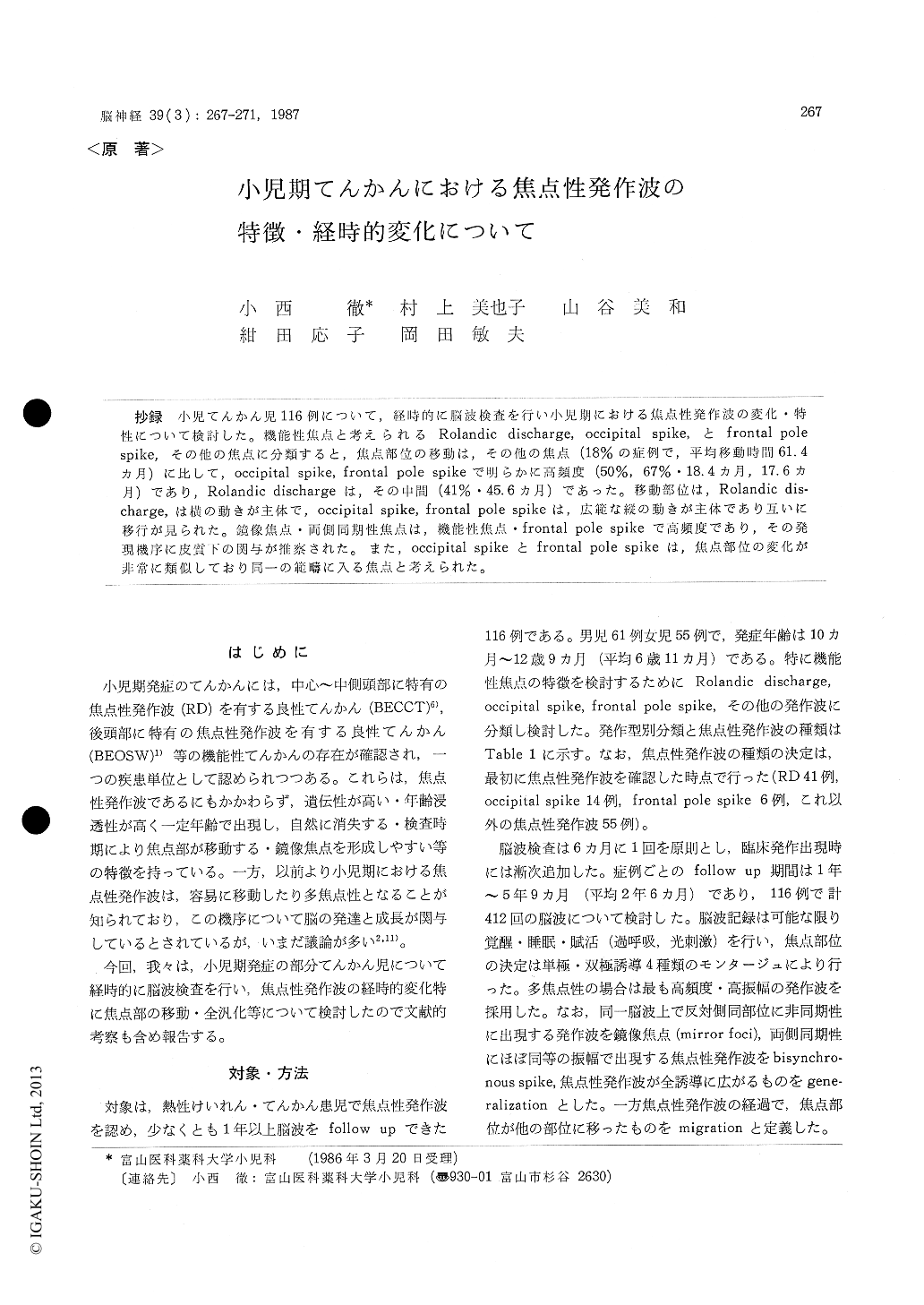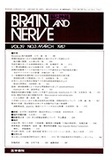Japanese
English
- 有料閲覧
- Abstract 文献概要
- 1ページ目 Look Inside
抄録 小児てんかん児116例について,経時的に脳波検査を行い小児期における焦点性発作波の変化・特性について検討した。機能性焦点と考えられるRolandic discharge, occipital spike,とfrontal polespike,その他の焦点に分類すると,焦点部位の移動は,その他の焦点(18%の症例で,平均移動時間61.4カ月)に比して,occipital spike, frontal pole spikeで明らかに高頻度(50%,67%・18・4カ月,17・6カ月)であり,Rolandic dischargeは,その中間(41%・45.6カ月)であった。移動部位は,Rolandic dis-charge,は横の動きが主体で,occipital spike,frontal pole spikeは,広範な縦の動きが主体であり互いに移行が見られた。鏡像焦点・両側同期性焦点は,機能性焦点・frontai pole spikeで高頻度であり,その発現機序に皮質下の関与が推察された。また,occipital spikeとfrontal pole spikeは,焦点部位の変化が非常に類似しており同一の範疇に入る焦点と考えられた。
We performed the longitudinal study in patients with focal spikes about characteristic changes in epileptic foci for periods of between one year and 5 years 9 months. The 116 epileptic children were evaluated, ranging in onset age from 10 month to 12 year 9 month old (mean age: 6 year 11 month). They were subdivided into four groups according to their region of foci: group 1, 41 patients with the centro-temporal spikes (Rolandic discharges); group 2, 14 patients with the occipital spikes; group 3, 6 patients with frontal pole spikes; group 4, 55 patients with the other focal spikes. EEG examinations were followed 6 months inter-val in each patients, and total 412 EEG trancing were investigated.
Migration of epileptic foci was recognized in thirty eight patients (32.8%): 17 (41%) in Rolan-dic discharges, 7 (50%) in occipital spikes, 4 (67%) in frontal pole spikes and 10 (18%) in other spikes. The mean time to the migration of next foci was 45.6 months in Rolandic discharges, 18.4 months in occipital spikes, 17.6 months in frontal pole spike and 61.4 months in other spikes. As to the regions of migrated foci, Rolandic dischrges tended to move to the near and horizontal areas such as from central to temporal. Whereas, occi-pital spikes and frontal pole spikes tended to move to the distant and vertical areas such as from occipital to frontal pole and from frontal pole to occipital. But other spikes showed no tendency. The mirror foci were recognized in 31 patients (27%); 20% in Rolandic discharges, 21% in occipital spikes, 83% in frontal pole spikes and 5% in other spikes. The bilateral-synchronous spikes were showed in 13 patients; 2% in Rolandic discharges, 43% in occipital spikes, 33% in fron-tal spikes and 7% in other spikes. And the gene-ralization of focal spike was showed in 45 patients (39%); 32% in Rolandic discharges, 50% in occi-pital spikes, 83% in frontal pole spikes and 36% in other spikes.
The Rolandic discharges and occipital spikes were concerned to the functional paroxysmal discharges (benign epilepsy in childhood with centro-temporal foci, benign epilepsy in childhood with occipital spike-wave), and appeared at early childhood and disappeared at adlescent. In this study, we discussed what these functional focal spikes were different in property from the other focal spikes on serial EEGs. Rolandic discharges and occipital spikes were identified more frequent to cause in migration, mirror foci, bilateral synchro-nous and generalization. This may suggest that these functional spikes are more related to subcor-tical systems about their epileptogenesis. On the other hand, the occipital spikes and the frontal spikes were similar changes about the incidence and region of migration. This may suggest that both occipital and frontal pole spikes are concern-ed to be the same category.

Copyright © 1987, Igaku-Shoin Ltd. All rights reserved.


